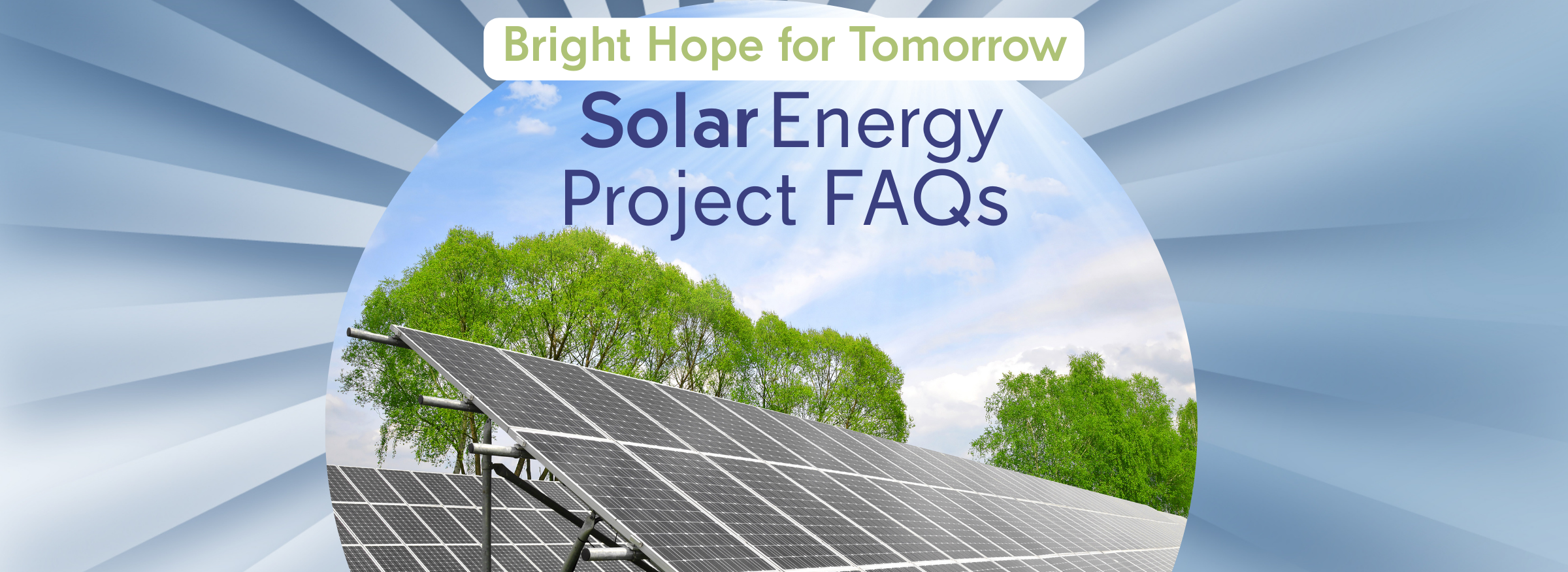Bright Home for Tomorrow: Your Questions Answered
At Bedford Presbyterian Church, we believe that caring for God’s creation is vital to our faith. As a newly certified PC(USA) Earth Care Congregation, we’re excited to share what this recognition means, how we got here, and how you can be part of our ongoing efforts. Below are answers to some of the most common questions about our Earth Care journey and what it means for our church and community.
- The plan is for two rows of 126 panels (total), two panels high in portrait mode, parallel to the slope of the hillside below the parking lot, on either side of the swale, between the parking lot fence and the dormant raised bed gardens. There will be no impact on the church buildings.
- The panels will be mounted on an open metal structure underneath the panels. Each panel is about the size and weight of a large window (about 8′ x 2.5′, 75 lbs). The panels are black glass, tilted at about 35 degrees, so the snow will generally slide right off. Any pollen will be washed away in the next rain. The panels are strong and would not be affected by hail or a temporary snow accumulation.
- The panels are bifacial, meaning they generate electricity from sunlight on the front of the panel and any direct or reflected light on the back of the panels (say, from sunlight reflected on snow).
- Light reflection will be no issue as the panels are pointed away from the church toward the sky.
- An underground wire will go from the panels underneath the parking lot into the basement of the church building to feed the main electrical panel.
- The church uses about 50,000 kWh annually (about five times the average NH home) for all its buildings, including the food pantry.
- The solar system is expected to produce about 100,000 kWh per year, twice what the church uses currently. This will allow the church to replace most of its heating and air conditioning (HVAC) systems that use fossil fuels with modern energy-efficient heat pumps using electricity provided by the solar system as the project’s next phase.
- The solar system will be installed first. Until new HVAC systems are installed, excess electricity produced by the solar system will be sent back onto the grid to be used by our neighbors (reducing the need for electricity from distant power plants). The utility (Eversource) will reimburse the church for that excess electricity (at a little less than the retail rate).
- The system will not need any batteries. At night and during cloudy days, when the solar system is not producing as much electricity as the church needs, the church will use electricity from the utility grid. During sunny days when the solar system produces more than the church needs, the excess will be put back onto the grid and offset the electricity drawn from the grid one-for-one, meaning the church will use the grid as an ‘effective battery.’
- The solar system will be blocked from the view of the road by primarily evergreen trees and bushes next to the road and will also be partially blocked from the view of the neighbor below the church by its solar system.
- The church is considering planting options under the panels. Its goal is to grow shade-tolerant perennial plants, preferably pollinator-friendly ones.
- The eventual goal is free, non-polluting, renewable solar energy that meets the church’s energy needs (heating, air conditioning, lights, and appliances).
- The solar company the church expects to use is the largest solar installer in New Hampshire and has completed many projects in town, including the $4.4M solar system on the town’s capped landfill, which is expected to meet all the municipal electrical needs. The company is one of the largest employers in the state (400+ employees) and is a certified B Corporation committed to serving the interests of employees, customers, and the community.
- There should be little impact on church or food pantry activities during the solar installation.
- The church expects to be able to use federal solar cash payments and a New Hampshire state rebate to partially offset the cost of the system.
- The church anticipates using federal solar cash payments and an NH state solar rebate to partially offset the cost of the system.
- Currently, there are no plans for charging stations, which could be added later.

